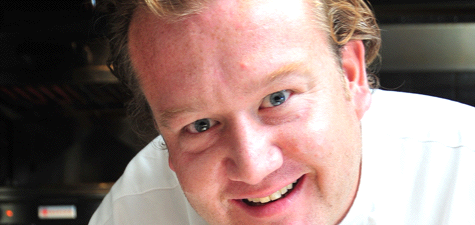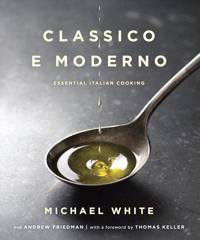
There seems to be a need among chefs and foodies to justify their love of Italian food – perhaps since Julia Child put French above Italian. Perhaps this is true of all cuisines – a desire to prove that the cuisine is both sophisticated and truly approachable – elevated and common – and that both are important elements in our desire to eat.
Take Michael White’s
Classico E Moderno: Essential Italian Cooking (
Balantine 2013) written with Andrew Friedman. It is, in fact, two books in one, yet both halves are tied together.
Classico is a collection of nearly 125 recipes for my favorite dishes from all over Italy….In the second half of the book, Moderno, you will find about the same number of recipes for many of the most popular dishes I serve in my restaurants, as well as others conceived in the same contemporary style. When it applies, a recurring feature called Inspirazione (Inspiration) in the Classico section will point you to dishes in Moderno that are based on them. (p. xxvi)
 So the idea is that you will probably cook from Classico at home, but learn to appreciate and contemplate the thinking of a modern chef through Moderno. The recipes in Classico have Italian titles, while the ones in Moderno are in English only – as if a further step removed from their inspiration. The introduction to both books includes a biography of Michael White’s culinary life, and for students of cookery, it is a good read. He has taken apprenticeship seriously, and built on luck of landing in the right restaurant at the right time with serious investigation and hard work.
So the idea is that you will probably cook from Classico at home, but learn to appreciate and contemplate the thinking of a modern chef through Moderno. The recipes in Classico have Italian titles, while the ones in Moderno are in English only – as if a further step removed from their inspiration. The introduction to both books includes a biography of Michael White’s culinary life, and for students of cookery, it is a good read. He has taken apprenticeship seriously, and built on luck of landing in the right restaurant at the right time with serious investigation and hard work.
It is interesting to compare chapters from the two halves of the book. They both have chapters on Antipasti E Insalate. In Classico, there is a recipe for Insalata Di Giovanna (p. 29) named after Michael’s wife. It’s a simple salad of mixed greens – Bibb lettuce, fennel, radicchio, radishes, and the like, with fresh herbs with lemon vinaigrette. There is a more complex and luxurious Porcini Con Uovo, Radicchio E Parmigianino (p. 37) and a rustic Pepata Di Cozze E Cannolicchi, or Mussels and Razor Clams with White Wine, Garlic, and Chile (p. 41) pictured with a slab of crusty bread ready to soak up the liquor. In the Moderno section, Michael offers a Salad of Raw Mushrooms, Charred Radicchio, and Pistachios (p. 184) that is hardly more sophisticated. There is a lovely Escarole and Crisp Vegetable Salad with Bang Caudal Vinaigrette (p. 185) that transforms the bang caudal of anchovies, garlic, and cream into a salad dressing rather than a hot sauce for vegetables. Both chapters focus their attention on tuna. In Classico, Michael will teach you how to preserve tuna (p. 33) facing the wonderful photograph of tuna in jars Evan Sung. They are used in Tonno E Fagioli, Preserved Tuna, Barletta Bean, and Red Onion Salad (p. 30). In Moderno, Michael uses sushi-grade tuna in Tuna with Oyster Cream and Crispy Sunchokes (p. 189) in a much more complex recipe.
You will be tempted to make recipes on from both sections – and perhaps play one on the other – creating crescendos of complexity that might startle and ultimately satisfy you. If you master a Classico recipe, there is a Moderno waiting to be tried. And that is the secret of a great cookbook – urging you on to try more things.
